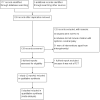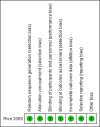Trihexyphenidyl for dystonia in cerebral palsy
- PMID: 29763510
- PMCID: PMC6494536
- DOI: 10.1002/14651858.CD012430.pub2
Trihexyphenidyl for dystonia in cerebral palsy
Abstract
Background: Cerebral palsy occurs in up to 2.1 of every 1000 live births and encompasses a range of motor problems and movement disorders. One commonly occurring movement disorder amongst those with cerebral palsy is dystonia: sustained or intermittent involuntary muscle spasms and contractions that cause twisting, repetitive movements and abnormal postures. The involuntary contractions are often very painful and distressing and cause significant limitations to activity and participation.Oral medications are often the first line of medical treatment for dystonia. Trihexyphenidyl is one such medication that clinicians often use to treat dystonia in people with cerebral palsy.
Objectives: To assess the effects of trihexyphenidyl in people with dystonic cerebral palsy, according to the World Health Organization's (WHO) International Classification of Functioning, Disability and Health (ICF) domains of impairment, activity and participation. We also assessed the type and incidence of adverse effects in people taking the drug.
Search methods: We searched CENTRAL, MEDLINE, Embase, eight other databases and two trials registers in May 2017, and we checked reference lists and citations to identify additional studies.
Selection criteria: We included randomised controlled trials comparing oral trihexyphenidyl versus placebo for dystonia in cerebral palsy. We included studies in children and adults of any age with dystonic cerebral palsy, either in isolation or with the associated movement disorders of spasticity, ataxia, chorea, athetosis and/or hypotonia. We included studies regardless of whether or not the study authors specified the method used to diagnose dystonia in their study population. Primary outcomes were change in dystonia and adverse effects. Secondary outcomes were: activity, including mobility and upper limb function; participation in activities of daily living; pain; and quality of life.
Data collection and analysis: We used standard methodological procedures expected by Cochrane.
Main results: We identified one study, which was set in Australia, that met the inclusion criteria. This was a randomised, double-blind, placebo-controlled, cross-over trial in 16 children (10 boys and 6 girls) with predominant dystonic cerebral palsy and a mean age of 9 years (standard deviation 4.3 years, range 2 to 17 years). We considered the trial to be at low risk of selection, performance, detection, attrition, reporting and other sources of bias. We rated the GRADE quality of the evidence as low.We found no difference in mean follow-up scores for change in dystonia as measured by the Barry Albright Dystonia Scale (BADS), which assesses eight body regions for dystonia on a 5-point scale (0 = none to 4 = severe), resulting in a total score of 0 to 32. The BADS score was 2.67 points higher (95% confidence interval (CI) -2.55 to 7.90; low-quality evidence), that is, worse dystonia, in the treated group. Trihexyphenidyl may be associated with an increased risk of adverse effects (risk ratio 2.54, 95% CI 1.38 to 4.67; low-quality evidence).There was no difference in mean follow-up scores for upper limb function as measured by the Quality of Upper Extremity Skills Test, which has four domains that collectively assess 36 items (each scored 1 or 2) and produces a total score of 0 to 100. The score in the treated group was 4.62 points lower (95% CI -10.98 to 20.22; low-quality evidence), corresponding to worse function, than in the control group. We found low-quality evidence for improved participation (as represented by higher scores) in the treated group in activities of daily living, as measured by three tools: 18.86 points higher (95% CI 5.68 to 32.03) for the Goal Attainment Scale (up to five functional goals scored on 5-point scale (-2 = much less than expected to +2 = much more than expected)), 2.91 points higher (95% CI 1.01 to 4.82) for the satisfaction subscale of the Canadian Occupational Performance Measure (COPM; satisfaction with performance in up to five problem areas scored on a 10-point scale (1 = not satisfied at all to 10 = extremely satisfied)), and 2.24 points higher (95% CI 0.64 to 3.84) for performance subscale of the COPM (performance in up to five problem areas scored on a 10-point scale (1 = not able to do to; 10 = able to do extremely well)).The study did not report on pain or quality of life.
Authors' conclusions: At present, there is insufficient evidence regarding the effectiveness of trihexyphenidyl for people with cerebral palsy for the outcomes of: change in dystonia, adverse effects, increased upper limb function and improved participation in activities of daily living. The study did not measure pain or quality of life. There is a need for larger randomised, controlled, multicentre trials that also examine the effect on pain and quality of life in order to determine the effectiveness of trihexyphenidyl for people with cerebral palsy.
Conflict of interest statement
Adrienne R Harvey is an Editor with the Cochrane Developmental, Psychosocial and Learning Problems Group (CDPLPG). She is funded through a Melbourne Children's Campus Career Development Award.
Louise B Baker was supported by the Lorenzo and Pamela Galli Charitable Trust during the early stages of this Cochrane Review, which was during the early stages of her Fellowship.
Dinah Susan Reddihough has received a grant from the Flack Trust, a charitable trust, for previous pilot work on the use of medications (benzhexol hydrochloride) for dystonia. The Flack Trust have no interest in the review’s findings that might lead to a real or perceived conflict of interest.
Adam Scheinberg ‐ none known.
Katrina Williams (KW) is an Editor with CDPLPG. KW declares that her position as APEX Australia Chair of Developmental Medicine is funded jointly by AFRID (APEX Foundation for Research into Intellectual Disability) and the Royal Children’s Hospital Foundation.
None of the authors were involved in the editorial processes associated with the publication of this review.
Figures
Update of
- doi: 10.1002/14651858.CD012430
References
References to studies included in this review
Rice 2009 {published data only}
-
- Rice J, Waugh M‐C. Trihexyphenidyl in the treatment of dystonic cerebral palsy: a pilot randomized controlled trial. Developmental Medicine & Child Neurology 2006;48(106 Suppl):12‐13. [onlinelibrary.wiley.com/doi/epdf/10.1111/j.1469‐8749.2006.tb12591.x]
References to studies excluded from this review
Reddihough 1990 {published data only}
Additional references
ACPR 2016
Allen 2014
Barry 1999
Bax 2006
Ben‐Pazi 2011
Carranza del Rio 2011
Deeks 2017
-
- Deeks JJ, Higgins JPT, Altman DG, editor(s), on behalf of the Cochrane Statistical Methods Group. Chapter 9: Analysing data and undertaking meta‐analyses. In: Higgins JPT, Churchill R, Chandler J, Cumpston MC, editor(s). Cochrane Handbook for Systematic Reviews of Interventions, Version 5.2.0 (updated June 2017). Cochrane, 2017. Available from www.training.cochrane.org/handbook.
Egger 1997
Endicott 1976
Ferber 2016
-
- Ferber R. 3‐D Gait. www.3dgaitanalysis.com/3d‐gait/ (accessed 3 March 2016).
GRADE 2004
GRADEpro GDT 2015 [Computer program]
-
- McMaster University (developed by Evidence Prime). GRADEpro GDT. Version (accessed prior to 19 April 2018). Hamilton (ON): McMaster University (developed by Evidence Prime), 2015.
Hanna 2008
-
- Hanna SE, Bartlett DJ, Rivard LM, Russell DJ. Reference curves for the Gross Motor Function Measure: percentiles for clinical description and tracking over time among children with cerebral palsy. Physical Therapy 2008;88(5):596‐607. [DOI: 10.2522/ptj.20070314; PMC2390723; PUBMED: 18339799] - DOI - PMC - PubMed
Higgins 2011a
-
- Higgins JPT, Deeks JJ, editor(s). Chapter 7: Selecting studies and collecting data. In: Higgins JPT, Green S, editor(s). Cochrane Handbook for Systematic Reviews of Interventions, Version 5.1.0 (updated March 2011). The Cochrane Collaboration, 2011. Available from handbook.cochrane.org.
Higgins 2011b
-
- Higgins JPT, Deeks JJ, Altman DG, editor(s). Chapter 16: Special topics in statistics. In: Higgins JPT, Green S, editor(s). Cochrane Handbook for Systematic Reviews of Interventions Version 5.1.0 (updated March 2011). The Cochrane Collaboration, 2011. Available from handbook.cochrane.org.
Higgins 2017
-
- Higgins JPT, Altman DG, Sterne JAC, editor(s). Chapter 8: Assessing risk of bias in included studies. In: Higgins JPT, Churchill R, Chandler J, Cumpston MS, editor(s). Cochrane Handbook for Systematic Reviews of Interventions Version 5.2.0 (updated June 2017). Cochrane, 2017. Available from training.cochrane.org/handbook.
Himmelmann 2007
Hoon 2001
-
- Hoon AH Jr, Freese PO, Reinhardt EM, Wilson MA, Lawrie WT Jr, Harryman SE, et al. Age‐dependent effects of trihexyphenidyl in extrapyramidal cerebral palsy. Pediatric Neurology 2001;25(1):55‐58. [PUBMED: 11483397] - PubMed
Jethwa 2010
-
- Jethwa A, Mink J, MacArthur C, Knights S, Fehlings T, Fehlings D. Development of the Hypertonia Assessment Tool (HAT): a discriminative tool for hypertonia in children. Developmental Medicine & Child Neurology 2010;52(5):e83‐7. [PUBMED: 20540176] - PubMed
King 2004
-
- King G, Law M, King S, Hurley P, Hanna S, Kertoy M, et al. Children's Assessment of Participation and Enjoyment (CAPE) and Preferences for Activities of Children (PAC). San Antonio (TX): Harcourt Assessment, Inc, 2004.
Law 2005
-
- Law MC, Baptise S, Carswell A, McColl MA, Polatajko H, Pollock N. Canadian Occupational Performance Measure. 4th Edition. Ottawa (ON): CAOT Publications Ace, 2005.
Masson 2017
Moher 2009
Monbaliu 2012
-
- Monbalui E, Orthibus E, Cat J, Dan B, Heyrman L, Prinzie P, et al. The Dyskinesia Impairment Scale: a new instrument to measure dystonia and choreoathetosis in dyskinetic cerebral palsy. Developmental Medicine & Child Neurology 2012;54(3):278–83. [PUBMED: 22428172] - PubMed
Narayanan 2007
-
- Narayanan UG, Weir S, Fehlings DL. Caregiver Priorities and Child Health Index of Life with Disabilities (CPCHILD©) Questionnaire: manual and interpretation guide. www.sickkids.ca/pdfs/Research/CPChild/6573‐CPCHILD_manual.pdf. (accessed prior to 23 April).
NIH 2005
-
- National Institutes of Health (NIH). Trihexyphenidyl. pubchem.ncbi.nlm.nih.gov/compound/trihexyphenidyl (accessed prior to 19 April 2018).
Oskoui 2013
PedsQL 1999
-
- Varni JW, Seid M, Rode CA. The PedsQLTM: measurement model for the pediatric quality of life inventory. Medical Care 1999;37(2):126‐39. [www.jstor.org/stable/3767218; PUBMED: 10024117] - PubMed
QUEST 1992
-
- DeMatteo C, Law M, Russell D, Pollock N, Rosenbaum P, Walter S. QUEST: Quality of Upper Extremity Skills Test. Hamilton (ON): McMaster University, CanChild Centre for Childhood Disability Research, 1992.
Randall 1999
-
- Randall MJ, Johnson LM, Reddihough DS. The Melbourne Assessment of Unilateral Upper Limb Function: Test Administration Manual. Melbourne (AU): Royal Children's Hospital, 1999.
RevMan 2014 [Computer program]
-
- Nordic Cochrane Centre, The Cochrane Collaboration. Review Manager (RevMan). Version 5.3. Copenhagan: Nordic Cochrane Centre, The Cochrane Collaboration, 2014.
Rosenbaum 2007
Sanger 2003
Sanger 2007
Schünemann 2017
-
- Schünemann HJ, Oxman AD, Higgins JPT, Vist GE, Glasziou P, Guyatt GH on behalf of the Cochrane GRADEing Methods Group and the Cochrane Statistical Methods Group. Chapter 11: Completing 'Summary of findings' tables and grading the confidence in or quality of the evidence. In: Higgins JPT, Churchill R, Chandler J, Cumpston M, editor(s). Cochrane Handbook for Systematic Reviews of Interventions, Version 5.2.0 (updated June 2017). Cochrane, 2017. Available from training.cochrane.org/handbook.
TUG 2005
WeeFIM 1994
-
- Msall ME, DiGaudio K, Rogers BT, LaForest S, Catanzaro NL, Campbell J, et al. The Functional Independence Measure for Children (WeeFIM). Conceptual basis and pilot use in children with developmental disabilities. Clinical Pediatrics 1994;33(7):421‐30. [DOI: 10.1177/000992289403300708; PUBMED: 7525140] - DOI - PubMed
WHO ICF 2003
-
- World Health Organisation (WHO). International Classification of Functioning, Disability and Health (ICF). www.who.int/classifications/icf/en/ (accessed 3 March 2016).
Williams 2006
-
- Williams G. Introduction to the High Level Mobility Assessment Tool. www.tbims.org/combi/himat/ (accessed 3 March 2016).
Wong‐Baker FACES Pain Rating Scale 2001
-
- The Wong‐Baker FACES Foundation. Wong‐Baker FACES® Pain Rating Scale. wongbakerfaces.org/ (accessed 3 March 2016).
Publication types
MeSH terms
Substances
LinkOut - more resources
Full Text Sources
Other Literature Sources
Medical
Miscellaneous






